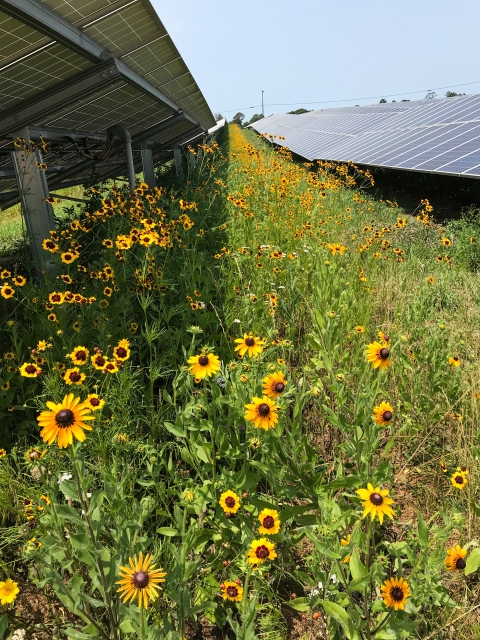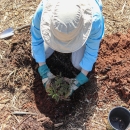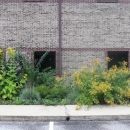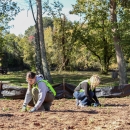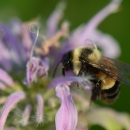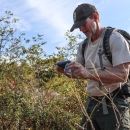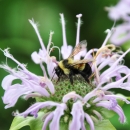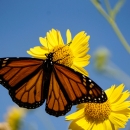States
North CarolinaThe rusty-patched bumble bee was once found from Georgia to Maine to the Dakotas. It hasn’t been seen in Western North Carolina since 2004 and in 2017 it was declared endangered, becoming the first bumble bee to receive Endangered Species Act protection.
For many, the rusty-patched bumble bee turned attention to the broader plight of pollinators. In 2020 the Service found that listing the monarch butterfly under the Endangered Species Act is warranted but precluded by higher priority actions, and several other bees and butterflies are slated for similar consideration in the coming years.
Habitat loss and degradation contributed to the decline of the rusty-patched bumblebee and a major part of the habitat loss faced by pollinators is simply the loss of the flowers they depend on when natural habitat is converted to intensive agriculture, parking lots, manicured lawns and similar flower un-friendly places; as well as the suppression of natural fire that would allow flowering herbaceous plants to flourish. When most people think about habitat management for wildlife, large expanses of natural areas likely come to mind - places where animals have room to roam, however anyone with a parcel of land, even a tiny one, can help provide pollinators with the flowers they need.
A conservation opportunity is discovered
Bryan Tompkins is a biologist with the Service’s Asheville Field Office whose primary responsibilities include reviewing energy projects for impacts to fish and wildlife and helping minimize or eliminate those impacts – think fish and hydropower dams, or forest bats and electrical transmission lines. As solar power increased in prominence, Tompkins began looking at the land beneath solar panels, typically maintained in a monoculture of fescue grass, as an untapped opportunity for planting pollinator-friendly plants, turning an area that offers little to pollinators into bona fide pollinator habitat.
After his initial work with power companies, Tompkins began looking to public spaces where pollinator-friendly plantings could educate and hopefully inspire people to install pollinator gardens on their private property. This led to the installation of pollinator gardens and meadows in public parks, like Mills River Park in Mills River, NC, and the Ochlawaha Greenway, in Hendersonville, NC, but the heart of the program is school gardens. The myriad open, mowed lawn areas on school properties provide an outstanding opportunity to install a pollinator garden, which can be a launching point for lessons and conversations not only about biology and environmental science, but also about agriculture, history,even math and language arts.
Partnerships with schools blossom
The Asheville Field Office’s schoolyard pollinator conservation program, led by Tompkins, is a multi-faceted community effort. The schools provide the site, labor for installation, and ongoing instruction after the garden is installed. The Service provides pollinator conservation programs and presentations, as well as the technical knowledge for the garden, including leading the students in designing and installing the garden. The plants for the gardens come from a local network of partnerships, cultivated by Tompkins - some are donated by area nurseries like Carolina Native and Painters Greenhouse while others are excess plants collected from thriving established gardens. The plants are stored at a pollinator plant bank hosted by local non-profit Asheville Greenworks until they’re needed for a garden. Schoolyard pollinator gardens have come to focus on schools in Buncombe County, NC, where the effort has been embraced by administrators and educators, with school system staff and Tompkins developing a K-12 curriculum that meets North Carolina education standards and incorporates the garden and pollinator conservation as an ongoing teaching tool.As part of the program, school staff agree to survey insects and flowers and sample garden soil for at least three years.Through partnership with Bee City Asheville, Tompkins provides ‘field backpacks’ to participating schools that contain tools, manuals, and data sheets to help the students complete the surveys. Tompkins also created an iNaturalist project page where survey data can be uploaded to the internet, compiled, and shared. Future plans include working with high school horticultural programs to assist with growing out the plants for school gardens and working with professors and students at local colleges and universities to provide presentations and programming to elementary schools in their area.
North Carolina pollinator species that are or may soon be protected by the Endangered Species Act
- American bumble bee
- Eastern beard grass skipper
- Frosted elfin butterfly
- Monarch butterfly
- Regal fritillary
- Rusty-patched bumble bee
- Southern plains bumblebee
- Variable cuckoo bumble bee
- St. Francis’s satyr butterfly
Pollinator gardens/meadows installed to date
Schools
- A.C. Reynolds High School, Asheville, NC
- Art Space Charter School, Swannanoa, NC
- Asheville-Buncombe Technical Community College, Asheville, NC
- Blue Ridge Community College, Flat Rock, NC
- Buncombe County Early College, Asheville, NC
- Buncombe County Virtual School/Haw Creek Elementary, Asheville, NC
- Enka Intermediate School, Enka, NC
- Evergreen Charter School, Asheville, NC
- Haywood Community College, Waynesville, NC
- Hazelwood Elementary, Hazelwood, NC
- IC Imagine Charter School, Asheville, NC
- Johnston Elementary, Asheville, NC
- Mt. Pisgah Academy, Enka, NC
- Nesbitt Discovery Academy, Asheville, NC
- Pisgah Elementary, Candler, NC
- Polk Central Elementary School, Mill Spring, NC
- T.C. Roberson High School, Asheville, NC
Other community spaces
- Asheville Field Office, Asheville, NC
- Bartram Walk Community Garden, Asheville, NC
- Beaver Lake Park, Asheville, NC
- Buncombe County Sports Park, Asheville, NC
- Deerfield Retirement Community, Asheville, NC
- I-26 Welcome Center, Mars Hill, NC
- I-77 Welcome Center, Charlotte, NC
- Kituwah Mound Site, Bryson City, NC
- Klondyke Housing Community, Asheville, NC
- Lake Julian Park – Monarch Waystation, Arden, NC
- Mills River Park, Mills River, NC
- North Asheville Post Office, Asheville, NC
- Ochlawaha Greenway, Hendersonville, NC.
- Piedmont Triad Farmers Market, Colfax, NC
- Western North Carolina Nature Center, Asheville, NC
- Wilma Dykeman Greenway Meadow, Asheville, NC
Partners
- Asheville Greenworks
- Asheville Housing Authority
- Bee City Asheville
- Buncombe County Master Gardeners
- Buncombe County Recreation Department
- Buncombe County Schools
- Carolina Native Nursery
- Champions for Wildlife
- City of Asheville
- Haywood Community College
- Lipscombe Family Foundation
- Painters Greenhouse
- Town of Mills River
- Town of Hendersonville
- Warren Wilson College
Sources
- Federal Register, vol. 82, No 7, January 11, 2017. Endangered and Threatened Wildlife and Plants; Endangered Species Status for Rusty Patched Bumble Bee. 3186 – 3208.
- Goulson, D., E. Nicholls, C. Bouias, E.L. Rotheray.2015.Bee declines driven by combined stress from parasites, pesticides, and lack of flowers.Science 347: 1255957-1-1255957-9.

